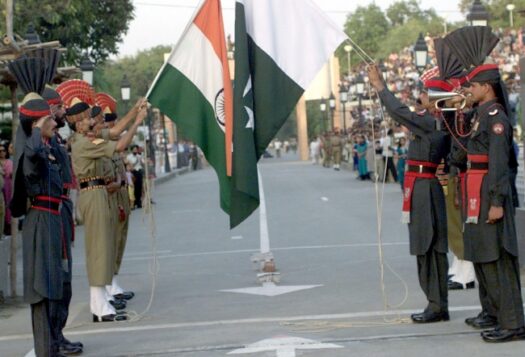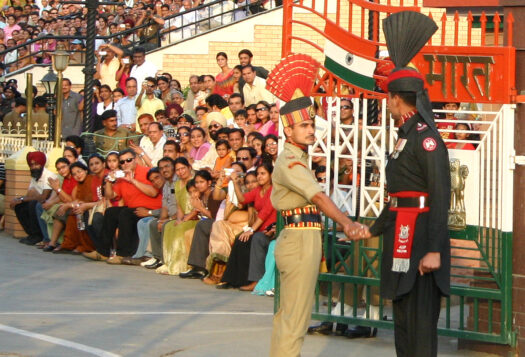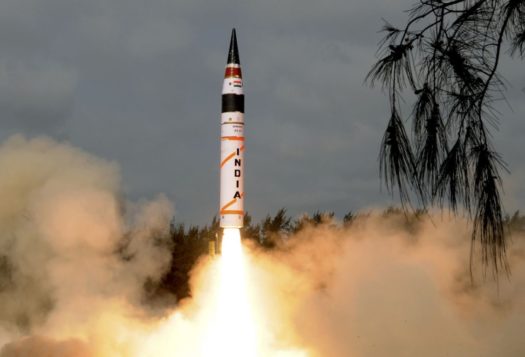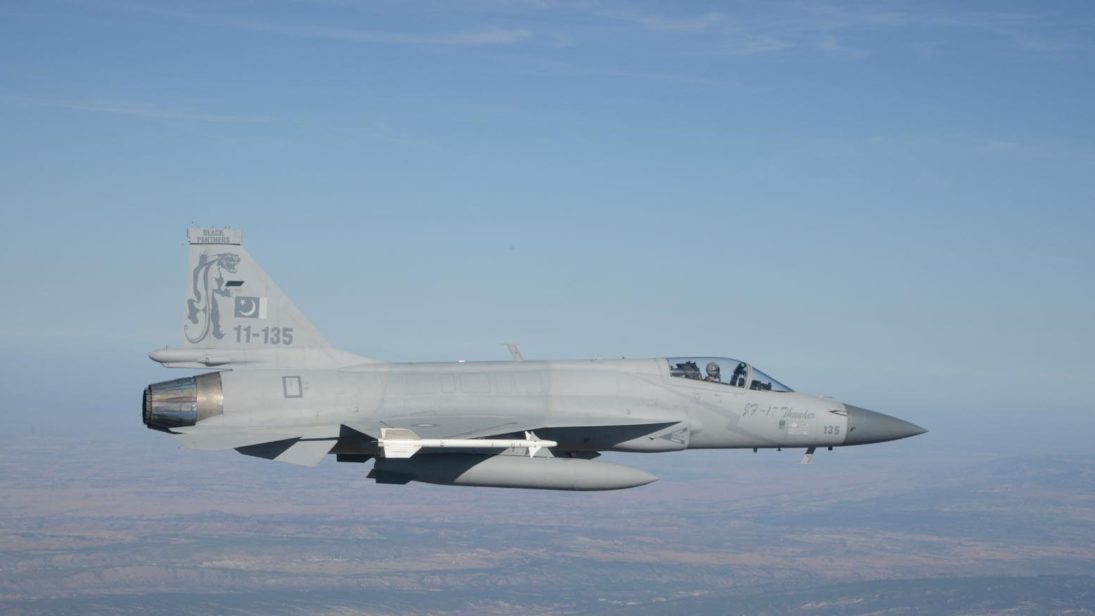
I. Introduction
South Asia’s security landscape is intricate and dangerous. Two nuclear weapon states, India and Pakistan, stand locked and loaded on a long and volatile border. The nuclear dyad has experienced previous close calls with escalatory potential, from the Kargil conflict in 1999 to the Balakot crisis in 2019. Deterrence stability in South Asia remains under stress because of enduring bilateral tensions, including the Kashmir dispute, and an ever-widening trust deficit between Islamabad and New Delhi. In this context, the application of force has become a preferred policy option versus negotiations and dialogue, risking crisis escalation from the sub-conventional to the conventional level with nuclear underpinnings. The fragile state of deterrence stability is not only important for India and Pakistan but also for the United States, which has long viewed regional crises with concern while playing a mediating role.
This memo examines the linkage between conventional deterrence and deterrence stability, and proposes that Pakistan bolster its conventional deterrence vis-à-vis India in order to strengthen stability while lessening its reliance on nuclear deterrence. Pakistan could do this by adopting a set of five recommendations: 1) redeployment of forces from the western to the eastern border; 2) improving jointness and integration; 3) enhancing aerial offensive and defensive capabilities; 4) making military diplomacy more robust; and 5) buttressing indigenous conventional-arms production.
The memo is a product of both primary and secondary research and is informed by interviews with experts and government officials based in Washington, DC; India; and Pakistan. The analysis that follows is divided into four sections that identify escalation under the nuclear umbrella as a challenge that needs attention, detail the limitations of previous policy approaches to address the issue, discuss the importance of conventional deterrence for deterrence stability, and provide policy recommendations to Pakistan and the United States.
The application of force has become a preferred policy option versus negotiations and dialogue, risking crisis escalation from the sub-conventional to the conventional level with nuclear underpinnings.
II. The Challenge: Escalation, Deterrence Stability, and Nuclear Weapons on the Subcontinent
The nuclear dyad in South Asia is often analyzed through the lens of Cold War nuclear rivals, the United States and Soviet Union. Grappling with the problem of deterrence stability in the Cold War, both sides stockpiled thousands of nuclear warheads and delivery systems to achieve parity. It was only after both sides had achieved a state of Mutually-Assured Destruction (MAD) and reached the brink of nuclear war that they entered into substantive discussions and agreements on arms control. 1
The case of South Asia is different—indeed, more challenging—in several ways. First, the two sides’ geographical contiguity represents a more immediate threat with dangerous connotations for stability. Second, longstanding disputes keep Islamabad and New Delhi at loggerheads, with the simmering situation in Kashmir sparking direct confrontation across the Line of Control (LoC) and triggering regular crises. Third, both sides’ relatively small arsenals, numbering under 200 each, complicate arms-control negotiations by limiting the range of potential reductions. Fourth, India and Pakistan must orient their security postures towards multiple audiences while navigating a strategic trilemma given the enormous role China plays within the region.
Some analysts credit the advent of nuclear weapons in the Subcontinent with the lack of all-out war between the two sides since 1998. The crises that have developed have remained limited in time, space, and intensity, often through the assistance of third-party crisis managers. In the recent Balakot crisis, for example, both sides opted for limited, conventional actions under the shadow of the nuclear umbrella. The risk of further escalation remained, however, as India had reportedly readied missiles to target Pakistan, prompting Islamabad to warn New Delhi of retaliatory strikes. As both sides have shown the proclivity to use force and fight a limited war, both advertent and inadvertent escalation could result.
While nuclear deterrence has seemingly succeeded in preventing a general war thus far, it is insufficient to prevent actions along the full conflict spectrum in South Asia. 2 The perceived window for limited kinetic action below the nuclear threshold has thus become a conflict accelerant. During crises, if both sides quickly climb non-nuclear rungs, they put pressure on high-end stability. Relieving this pressure requires putting in place a series of non-nuclear means to enhance deterrence stability.
III. Previous Policy Responses: No Headway through Confidence-Building Measures
Threats to deterrence stability have become more acute due to the absence of workable and effective confidence-building measures (CBMs). Though some CBMs are in place—including the 1988 Non-Attack Agreement prohibiting action against nuclear installations and agreements on pre-notifications of flight testing of ballistic missiles and reducing the risks of nuclear weapons-related accidents—their impact in addressing and preventing dangerous crises that challenge deterrence stability remains limited.
While nuclear deterrence has seemingly succeeded in preventing a general war thus far, it is insufficient to prevent actions along the full conflict spectrum in South Asia.
One attempt at a more robust CMB was made soon after the 1998 nuclear tests in the form of a Strategic Restraint Regime (SRR). In September of that year, Islamabad proposed an SSR via a non-paper that included three sets of proposals on conflict resolution, conventional restraint and nuclear. The SRR suggested a set of principles to move forward that included the creation of a conducive environment for conflict resolution, creation of a fair SRR that balanced obligations on both sides, establishment of an institutionalized crisis-prevention mechanism, and the recognition that conventional asymmetry affected Pakistan’s deterrence mix. Pakistan made the proposed nuclear restraint agreement contingent upon conventional restraint, as it was concerned about its conventional asymmetry with India. According to Pakistani nuclear scholar Brig. Feroz Khan, “India’s refusal to accept this pillar or entertain related proposals contributed to the failure of Pakistan’s diplomatic initiative.” 3 India’s threat perceptions regarding China no doubt played a role in limiting its willingness to accept constraints on conventional capabilities.
Coming to the present day, the part of the SRR that dealt with conflict resolution makes any such proposal a non-starter under the current circumstances. India, alleging that Pakistan has repeatedly scuttled chances of establishing peace and friendship by sponsoring anti-India militants, maintains that talks and terrorism cannot go together. India, meanwhile, continues to buttress its conventional capabilities owing to the perceived threats it feels from China. Because India is likely to continue an arms build-up to counter China, meaningful headway in arms control between India and Pakistan is all but impossible. India’s military modernization could also be disconcerting for Pakistan given recent suggestions that India could seek to capture Pakistan’s administered territories including Pakistan-Administered Kashmir and Gilgit-Baltistan.
Proposals of resuscitating a strategic dialogue between India and Pakistan or toying with other off-ramps are likewise currently untenable given heightened tensions between the two sides over Jammu and Kashmir after India’s revocation of the area’s special status through Articles 370 and 35A. This August 5, 2019 gambit changed Pakistan’s stance from one of showing newfound willingness to extend an olive branch to ruling-out talks with India. Pakistan, for its part, will continue to link nuclear restraint with conventional capabilities and settlement of disputes, especially that of Jammu and Kashmir. All this does not bode well for any kind of dialogue between the two countries, let alone talks on arms control.
Because chances of conflict do pose significant threats to deterrence stability, a different method is needed to strengthen it.
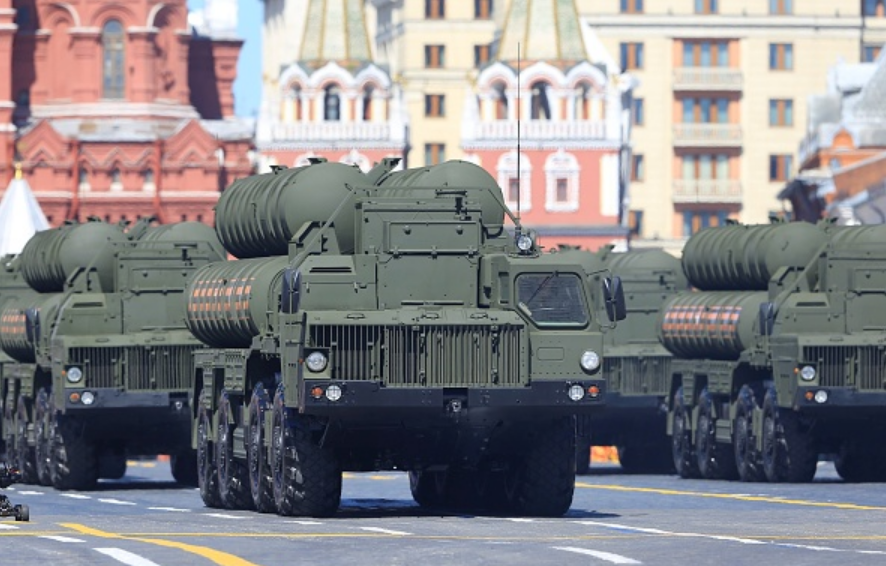
IV: Discussion: Stability through Conventional Deterrence
In his pathbreaking book, Conventional Deterrence, John Mearsheimer defined the concept as denying the adversary battlefield objectives through conventional forces. One aspect of the theory is important for Pakistan. According to Mearsheimer, conventional deterrence is not only about offensive or defensive weapons but also depends upon political considerations and military strategy. The aim of conventional deterrence is to elongate the battle and disallow a quick attainment of aim to the adversary. Deterrence is likely to hold when a potential aggressor believes that quick victory cannot be achieved. 4
Herman Kahn highlighted another key aspect of deterrence in one of his seminal works, On Escalation, arguing that it is the fear of the adversary’s reaction that deters escalation rather than desirability and costs. 5 In Pakistan’s case at the nuclear level, its undeclared nuclear doctrine is based upon a first-use policy under which Islamabad retains its right to use nuclear weapons against its adversary without first having suffered a nuclear strike on its territory. Other red lines include the space military, economic, and domestic thresholds. 6 Below these thresholds, however, India has increasingly sought to operate at the conventional level – demonstrating that fear of its adversary’s reaction is no longer deterring its actions. The proclivity to fight a limited war under a nuclear umbrella can be seen in the recent Pulwama-Balakot crisis and in its Cold Start Doctrine. Pakistan, in turn, has developed more limited nuclear options including tactical nuclear weapons in an attempt to deter such operations.
The proposed focus on conventional deterrence is merited in order to plug this gap and stave off nuclear use. Pakistan confronts an adversary in India that is hedging its bets on achieving a quick victory before third parties enter the fray. According to Walter C Ladwig III,
“[t]he goal of this limited war doctrine is to establish the capacity to launch a retaliatory conventional strike against Pakistan that would inflict significant harm on the Pakistan Army before the international community could intercede, and at the same time, pursue narrow enough aims to deny Islamabad a justification to escalate the clash to the nuclear level.” 7
For Pakistan, having more non-nuclear means to answer these challenges would enhance deterrence. As Vipin Narang put it, “nuclear weapons are not meant to deter airstrikes.”
In my discussions with leading experts, many highlighted linkages between the sub-conventional-, conventional-, and nuclear-level as a critical factor in escalation dynamics. A sub-conventional event that India believes is Pakistan-driven prompts conventional-level responses. A weak conventional deterrent, in turn, puts greater pressure on nuclear weapons as a means of escalation control, something which is inherently destabilizing. The importance of conventional deterrence was highlighted by retired Indian general, who argued,
“[an] adverse situation in a proxy war will force the aggrieved nation to raise the ante to air-, land-, and sea-based surgical strikes and other operations below the nuclear threshold. These will have to be countered by maintaining requisite conventional deterrent for quid pro quo action.” 8
It follows that more non-nuclear capabilities can give a state more options before nuclear use.
That said, U.S.-based scholars also identified impediments to building deterrence stability via a strengthened Pakistani conventional deterrent. First, such an approach could spark a conventional arms race between New Delhi and Islamabad, as India could perceive Pakistan’s actions as threatening. While this risk bears consideration, any incremental increase in Pakistani conventional capabilities would, in reality, do little to redress the large asymmetry in sizes between the two countries’ militaries. Moreover, deterrence is not only about playing on an adversary’s capabilities but on its intent. Thus, how and where Pakistan configures its forces can also contribute positively to deterrence while limiting the potential for arms racing.
Technology by itself can only make a marginal difference in the already-incendiary environment between the two rivals. The real origins of escalation lie in the realms of strategy and politics with the biggest casus belli in the Kashmir disputing festering by the day.
It is also noteworthy that one of the reasons why Pakistan needs to strengthen its deterrent is India’s rapid modernization of its military equipment. Systems like the S-400 and the Rafale aircraft are not only force-multipliers but have the propensity to discredit Pakistan’s deterrence mix. India has also officially committed itself to enhancing the capacity and capability of its armed forces to deal with threats. Instead of Pakistan looking at nuclear options to plug the gaps, it should focus on conventional antidotes that allow it to mount responses in the same domain rather than risk horizontal escalation.
One of the most pressing issues associated with a strengthened Pakistani conventional deterrent is how dual-use technologies could undermine and subvert deterrence stability. The concerns of the D.C.-based experts emanate from the ever-increasing misperceptions and lack of bilateral channels of communication between the two countries. They argued that these factors could lead to misinterpretations and miscalculations in future crises. That said, technology by itself can only make a marginal difference in the already-incendiary environment between the two rivals. The real origins of escalation lie in the realms of strategy and politics with the biggest casus belli in the Kashmir disputing festering by the day. A similar argument was made by Dr. Caitlin Talmadge in a recent article that looked at the linkage between technology and escalation during the Cold War. 9
The problem of India construing Pakistani conventional enhancements as a nuclear threat appears to be insignificant in the context of existing capabilities. Pakistan has clearly articulated the role that nuclear weapons and their platforms play at all levels of war. With an array of dual-use capabilities already inducted by both India and Pakistan, incremental conventional enhancements will likely not add much to already-high levels of mistrust or the fog of conflict.
Experts in Washington, D.C. termed Pakistan’s weak economic profile as one of the biggest impediments to a strengthened conventional deterrent. They contended that Pakistan, beset with debt, low-growth and structural anamolies, will find it difficult to afford sustained investments in defense that could help keep a semblance of balance with a behemoth economic power, India. There is no doubt that Pakistan is in the midst of an economic crisis. That said, the country is slowly but surely extricating itself from dire straits. According to the World Bank, Pakistan could become a 2-trillion-dollar economy by 2047. This statistic inspires confidence given that nothing proposed in this memo caters to the short and medium terms. Even were economic challenges to persist, triggered by China Pakistan Economic Corridor (CPEC) investments, COVID-19 response, or otherwise, many policy options recommended below involve allocation of existing resources rather than significant new expenditures.
A final question raised during my interviews was how India would view China’s military support to Pakistan. Though India may construe the China-Pakistan bonhomie as a veritable threat, its impact on the trajectory and pace of India’s conventional advancements may not be that significant. India stands well ahead of Pakistan in military size and is already undertaking a significant modernization project. It also bears mentioning that India’s fear of encirclement are mirrored by similar concerns in Pakistan regarding the growing Indo-U.S. defense partnership. By virtue of being China’s strategic partner, Pakistan will inevitably be impacted by a U.S.-Indo partnership designed to create a bulwark against a burgeoning China.
This memo recommends thinning out forces from the Afghan border and redeploying them back to their pre-2001 positions. This would improve Pakistan’s force ratio versus India, giving it a cost-effective option to add to its conventional prowess along the LoC, Working Boundary (WB), and the International Border (IB).
V: Policy Recommendations
The preceding analysis has argued for Pakistan to buttress its conventional deterrence while managing associated risks. Accordingly, I propose the following policy recommendations:
1) Redeploy to Redress the East-West Balance
The Pakistani armed forces were traditionally equipped, deployed, and trained to fight a conventional war with India. However, the military’s deployment changed in 2001. While Pakistan maintained its deployment balance in favor of its eastern border with India, it became and remains committed on the Afghan border. By 2018, some 200,000 troops were engaged in the western theater. This memo recommends thinning out forces from the Afghan border and redeploying them back to their pre-2001 positions. This would improve Pakistan’s force ratio versus India, giving it a cost-effective option to add to its conventional prowess along the LoC, Working Boundary (WB), and the International Border (IB). Exercising this option is tenable, barring a return to significant conflict in Afghanistan, due to relative improvements in the cross-border security situation as well as the construction of the border fence.
2) Improve Jointness and Integration
Seeking to deny an enemy battlefield objectives through conventional means is also a function of military strategy. The study proposes to increase jointness of war-planning and fighting by empowering the Chairman Joint Chiefs of Staff Committee (CJCSC). This committee could develop a joint force doctrine to be tested and employed through simulations and exercises. Increased coordination would help in better intelligence-sharing and multi-domain preparedness, signaling to adversaries Pakistan’s intent and capacity to retaliate.
3) Strengthening Aerial Defensive and Offensive Capabilities
The recent Pulwama-Balakot crisis saw India use airpower to target mainland Pakistan. Pakistan thus needs to focus on making incremental improvements in its air combat capabilities, both in a bid to enhance its ability to deny India objectives in an air duel and to retaliate quickly. The relatively less costly ways to improve capabilities would be to acquire JF-17 Block III aircraft and an HQ-9 air defense system from China. Despite the questionable efficacy of these two platforms, they suit Pakistan given its economic situation. In the next five to ten years, Pakistan should aim to replace its F-7 and Mirage aircraft accordingly. It must likewise ensure that beyond visible range (BVR) capabilities on its JF-17 fleet and airborne intercept radars are improved and strengthened.
4) Making Military Diplomacy More Robust
Pakistan should ramp-up its military diplomacy with friendly countries. Its growing strategic partnerships with China and Saudi Arabia should provide an easier conduit to expand military-to-military relations. With China’s rising stakes and security concerns in Pakistan, Islamabad must put a premium on augmenting the military components of its relations with Beijing. Technology-sharing and training should be the hallmarks of an increased level of military partnership between the two countries. Given China’s growing developmental works and investments in the Gwadar port, Pakistan must also engage China in naval diplomacy. Efforts should likewise be made to take Pakistan-Russia military relations from the tactical to the strategic level, something that could give Pakistan access to advanced defense purchases.
5) Buttressing Indigenous Conventional-arms Production.
In the medium-to-long term, Pakistan should invest in and increase its domestic defense-production base. This appears untenable under the current circumstances given economic constraints, but it remains a key priority if Pakistan is to reduce costs and its reliance on foreign suppliers. Islamabad could focus on improving production capacities of aircraft and missiles that can carry conventional payloads.
Taken together, these policy recommendations are implementable in the medium-to-long term but require near-term planning to be effectively executed. In the process, policymakers and military planners would do well to bear in mind the potential pitfalls identified above, most of which emanate from the ever-widening trust deficit between India and Pakistan.
Conclusion
The situation in South Asia appears dire, as India and Pakistan continue to harden their positions on unsettled disputes while brandishing nuclear weapons. Dialogue has been supplanted by saber-rattling and the propensity to use force. With crisis triggers an ever-present threat, the trust deficit at an all-time high, and third parties increasingly constrained in managing crises, deterrence stability on the Subcontinent is a challenge that merits attention. In the absence of bilateral avenues of engagement on crisis management and conflict resolution, bolstering deterrence stability becomes all the more important. Conventional deterrence is a less costly, more realistic option for Pakistan to enhance bilateral deterrence with India while keeping the threshold for nuclear use high.
Stimson South Asia Program Visiting Fellows represent a diversity of perspectives and experience. As members of a term academic program, their writing and views do not necessarily represent those of the South Asia program or of the Stimson Center.
Editor’s Note: This piece is part of a collection of policy memos published by South Asian Voices Visiting Fellows and was originally published on the Stimson Center website. The Visiting Fellowship is a year long fellowship that combines professional development of research, writing, and public speaking skills with extensive exposure to the D.C. policy community. More information on the South Asian Voices Visiting Fellowship is available here.
***
Image 1: Government of Pakistan
Image 2: Sefa Karacan/Anadolu Agency via Getty Images
- Office of the Historian, U.S. Department of State, The Limited Test Ban Treaty, 1963, accessed February 23, 2020
- Devin T.Hagerty, Nuclear Weapons and Deterrence Stability in South Asia, (Switzerland: Palgrave MacMillan, 2019)
- Feroz Hassan Khan, “Strategic Restraint Regime 2.0,” in Deterrence Stability and Escalation Control in South Asia: eds. Michael Krepon and Julia Thompson (Washington DC: Stimson Center, 2013), 167.
- John J. Mearsheimer, Conventional Deterrence (Ithaca, NY: Cornell UP 1983), 23-24.
- Herman Kahn, On Escalation: Metaphors and Scenarios (New York, Routledge, 2017).
- Peter Lavoy, “Pakistan’s Nuclear Posture: Security and Survivability,” Nonproliferation Policy Education Center, January 21, 2007, accessed March 23, 2020, http://npolicy.org/article.php?aid=291&tid=30.
- Walter C. Ladwig III, “A Cold Start for Hot Wars?” The Indian Army’s New Limited War Doctrine,” International Security 32, no.3 (2007), 164.
- Author’s Conversation with a Retired Indian General Via Email, 11 July, 2019.
- Caitlin Talmadge, “Emerging technology and intra-war escalation risks: Evidence from the Cold War, implications for today,” Journal of Strategic Studies, 42:6 (2019), 864-887.
